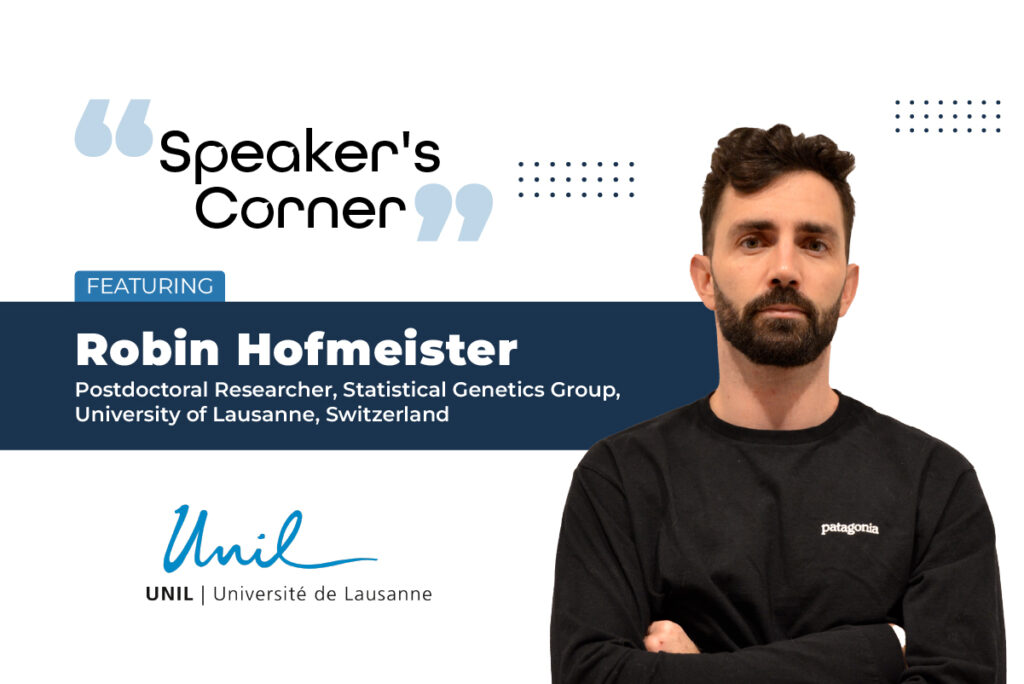
Robin Hofmeister holds a biology degree from the University of Lausanne, with a specialization in bioinformatics achieved during the Master’s program conducted in Ana Claudia Marques’ research group. The focus of this period was on investigating the causal connections between long non-coding RNAs (lincRNAs) and protein-coding genes within the context of breast cancer.
Following the Master’s degree, he pursued a doctoral program under the guidance of Olivier Delaneau, successfully completing it in June 2023. The doctoral research primarily centered on refining techniques for utilizing haplotype data in large cohorts, particularly focusing on datasets like the UK Biobank, which aggregates genetic and phenotypic information for approximately half a million individuals.
His noteworthy contributions included improvements to haplotype estimation methods for whole-genome sequencing data and the development of an innovative approach to ascertain the ancestral origin of these haplotype estimates by leveraging information from distant relatives.
In July 2023, Robin transitioned to the SGG group under the supervision of Zoltán Kutalik. In this new role, he is dedicated to deciphering the phenotypic consequences associated with alleles that are not transmitted by parents.
Now, in an interview with Eventible, Robin speaks about his background in detail, his take on collaborative research, his advice to individuals interested in pursuing a career in statistical genetics, his experience attending the 2nd Annual Bio-IT World Europe Conference & Expo, and much more!
- Can you share your academic and research background and what led you to specialize in statistical genetics?
I completed a general biology BSc program, covering diverse areas such as plant biology, microbiology, and animal biology. Subsequently, I pursued a specialization in Molecular Life Science with a minor in bioinformatics. During this period, I gained exposure to the intricacies of the human genome, particularly through large-scale genetic studies like GWAS. This experience fueled my interest in statistical genetics, leading me to focus on human genetics in a bioinformatics context during my Ph.D. My research, guided by my supervisor, delved into haplotypes, their estimation, and their application in analyzing complex trait associations.
2. As a Postdoctoral Researcher in the Statistical Genetics Group, what are the key focus areas of your research, and how do they contribute to our understanding of genetics?
My research primarily revolves around developing innovative approaches to maximize the potential of data within large cohorts. I specialize in the estimation of haplotype features from genotype data and the subsequent application of haplotypes in association testing. This focus contributes to advancing our understanding of genetics by providing robust tools for analyzing and interpreting genetic data at a larger scale.
3. The field of statistical genetics is interdisciplinary. How do you collaborate with researchers from other disciplines, and what benefits does this interdisciplinary approach bring to your work?
Collaboration is key to my research, and I actively seek partnerships with researchers from diverse disciplines. By collaborating with groups that have access to different biobanks or want to apply my methods to their cohorts, I ensure the broad applicability of my approaches. This interdisciplinary collaboration strengthens the reproducibility of my methods across various cohorts.
4. Can you discuss a specific research project you have been involved in recently? What were the goals, methodologies, and key findings of the project?
I recently participated in a project focusing on estimating haplotypes within the UK Biobank whole-genome sequencing dataset. While not following the traditional research project structure, our application of phasing methods to the existing 200,000 whole-genome sequences in the UK Biobank holds considerable significance. The project is designed to enhance subsequent analyses, encompassing genotype imputation, identifying compound heterozygotes, and exploring parent-of-origin effects. Looking ahead, we are excited to extend this methodology to the forthcoming release of the UK Biobank’s 500,000 whole-genome sequences, marking a pivotal milestone in the realm of genetic research.
5. Genomic data can be vast and complex. How do you approach the analysis of large-scale genetic datasets, and what computational tools or methodologies do you find particularly effective in your research?
Gratitude goes to developers of scalable tools, such as bcftools, plink, Regenie, and Bolt-LMM, which have greatly facilitated my analysis of large-scale genetic datasets. Leveraging these tools allows for more efficient and comprehensive analyses, significantly streamlining the process of conducting human genetic research.
6. The application of statistical genetics has implications for various fields, including medicine and biology. How do you see your research contributing to advancements in these areas?
With my former research colleagues, we recently demonstrated how haplotype information from the UK Biobank WGS dataset can be utilized to detect compound heterozygote events, shedding light on complex traits and diseases. These events occur when an individual carries two different heterozygous loss-of-function mutations located on the two different haplotypes, resulting in the equivalent of a double gene knockout. This highlights the potential of haplotype information to uncover the genetic contributions to various conditions, offering valuable insights for personalized medicine and advancing our understanding of genetic factors underlying diseases.
7. Collaborative research often involves working with teams. How do you foster effective collaboration and communication within your research group and with external collaborators?
Effective collaboration is fostered through active participation in international conferences, facilitating in-person discussions on common research interests. I am also deeply involved in collaborative projects, particularly those with researchers from different biobanks or consortiums. This collaborative approach allows for meta-analyses, maximizing the genetic resources available and increasing sample sizes, as exemplified by the success of the GIANT consortium.
8. Given the rapid advancements in genomic technologies, how do you stay updated on the latest tools and methodologies in statistical genetics, and how does this inform your research?
My primary means of staying updated is attending international conferences and providing a condensed update on several years of research in a week. Additionally, I stay informed through social media platforms like Twitter, where I follow selected researchers in my field. This continuous engagement ensures that I remain abreast of the latest tools and methodologies, informing the evolution of my research.
9. Data privacy and ethical considerations are important in genetics research. How do you address these concerns in your work, especially when dealing with sensitive genomic information?
Working predominantly with large biobanks like the UK Biobank, I ensure that data is stored in secure environments with robust authentication systems. Sensitive data clusters are employed to prevent unauthorized access, guaranteeing that external sources can only access summary statistics devoid of individual-level information.
10. The Statistical Genetics Group is likely involved in teaching and mentoring. How do you approach the mentorship of students, and what advice do you have for individuals interested in pursuing a career in statistical genetics?
Mentorship involves active engagement, and I encourage an open and collaborative learning environment within the group. I advise aspiring researchers in statistical genetics to seek diverse experiences, actively participate in collaborative projects, and stay informed about the latest advancements in genetics and statistical methodologies.
11. The field of genetics is constantly evolving. What challenges do you foresee in the future of statistical genetics, and how do you think researchers can address these challenges?
The increasing sample size in biobanks poses a significant challenge, necessitating the development of novel methods that can scale effectively. Efficient compression methods for large datasets also emerge as a crucial concern, emphasizing the need for researchers to innovate and adapt to the evolving landscape of genetic research.
Genetic research has implications for personalized medicine. How do you envision the role of statistical genetics in shaping the future of personalized healthcare?
Identifying new drug targets through GWAS signals underscores the potential of statistical genetics in shaping personalized healthcare. By shifting focus from validating existing candidates to identifying novel drug targets, statistical genetics can be pivotal in advancing personalized medicine.
Are there specific genetic traits or conditions that you find particularly intriguing or challenging to study, and what motivates your interest in these areas?
I approach my work with a broad perspective, applying my methods to various traits in large cohorts. This allows me to contribute to understanding a wide range of genetic traits and conditions without specific preferences. The motivation lies in the universal applicability of my approaches to diverse areas of genetic research.
12. As a researcher, how do you balance the pursuit of innovative research questions with the need for reproducibility and rigor in scientific studies?
In my view, the utility of a method hinges on its replicability by different individuals on the same and different datasets. Despite challenges in replicating results due to restricted access to large biobanks, I actively adapt to user feedback, utilizing platforms like GitHub’s issue system to ensure continuous improvement and rigorous validation.
13. How was your experience attending the 2nd Annual Bio-IT World Europe Conference & Expo, and what was your takeaway?
Unfortunately, I was unable to attend in person, and I appreciate the efforts made to facilitate the online presentation of my work.
Looking ahead, what research goals or projects are you excited about, and how do you see the field of statistical genetics evolving in the coming years?
I am particularly excited about the prospects offered by the 500,000 whole-genome sequences from the UK Biobank, enabling a closer examination of rare non-coding variants. Additionally, the Our Future Health project holds immense potential with its cohort of 5 million individuals. I anticipate these datasets will propel genetic research both at rare and common variants.




Comments are closed.